MOSEL Survey: JWST Reveals Major Mergers/strong Interactions Drive the Extreme Emission Lines in the Early Universe
IF 11.7
1区 物理与天体物理
Q1 ASTRONOMY & ASTROPHYSICS
引用次数: 0
Abstract
Abstract Extreme emission line galaxies (EELGs), where nebular emissions contribute 30%–40% of the flux in certain photometric bands, are ubiquitous in the early Universe ( z > 6). We utilize deep NIRCam imaging from the JWST Advanced Deep Extragalactic Survey ( JADES ) to investigate the properties of companion galaxies (projected distance <40 kpc, ∣ dv ∣ < 10,000 km s −1 ) around EELGs at z ∼ 3. Tests with TNG100 simulation reveal that nearly all galaxies at z = 3 will merge with at least one companion galaxy selected using similar parameters by z = 0. The median mass ratio of the most massive companion and the total mass ratio of all companions around EELGs is more than 10 times higher the control sample. Even after comparing with a stellar mass and stellar mass plus specific star formation rate (SFR)-matched control sample, EELGs have 3 to 5 times higher mass ratios than the brightest companion and total mass ratio of all companions. Our measurements suggest that EELGs are more likely to be experiencing strong interactions or undergoing major mergers irrespective of their stellar mass or specific SFRs. We suspect that gas cooling induced by strong interactions and/or major mergers could be triggering the extreme emission lines, and the increased merger rate might be responsible for the overabundance of EELGs at z > 6.MOSEL调查:JWST揭示早期宇宙中主要合并/强相互作用驱动极端发射线
极端发射线星系(EELGs)在早期宇宙中无处不在,在这些星系中,星云辐射在某些光度波段贡献了30%-40%的通量(z >6).我们利用来自JWST高级深星系外巡天(JADES)的深NIRCam成像来研究伴星系的性质(投影距离<40 kpc,∣dv <10000 km s−1)在z ~ 3的EELGs周围。TNG100模拟测试显示,几乎所有z = 3的星系都会与至少一个伴星星系合并,伴星星系的选择参数与z = 0相似。大质量伴星的中位数质量比和EELGs周围所有伴星的总质量比是对照样本的10倍以上。即使在与恒星质量和恒星质量加上特定恒星形成率(SFR)匹配的对照样本进行比较后,EELGs的质量比也比最亮的伴星和所有伴星的总质量比高3到5倍。我们的测量表明,eelg更有可能经历强烈的相互作用或经历重大合并,而不管它们的恒星质量或特定的srr如何。我们怀疑,由强相互作用和/或主要合并引起的气体冷却可能触发了极端的发射线,并且合并率的增加可能是导致z >6.
本文章由计算机程序翻译,如有差异,请以英文原文为准。
求助全文
约1分钟内获得全文
求助全文
来源期刊

Astrophysical Journal Letters
ASTRONOMY & ASTROPHYSICS-
CiteScore
14.10
自引率
6.30%
发文量
513
审稿时长
2-3 weeks
期刊介绍:
The Astrophysical Journal Letters (ApJL) is widely regarded as the foremost journal for swiftly disseminating groundbreaking astronomical research. It focuses on concise reports that highlight pivotal advancements in the field of astrophysics. By prioritizing timeliness and the generation of immediate interest among researchers, ApJL showcases articles featuring novel discoveries and critical findings that have a profound effect on the scientific community. Moreover, ApJL ensures that published articles are comprehensive in their scope, presenting context that can be readily comprehensible to scientists who may not possess expertise in the specific disciplines covered.
 求助内容:
求助内容: 应助结果提醒方式:
应助结果提醒方式:


